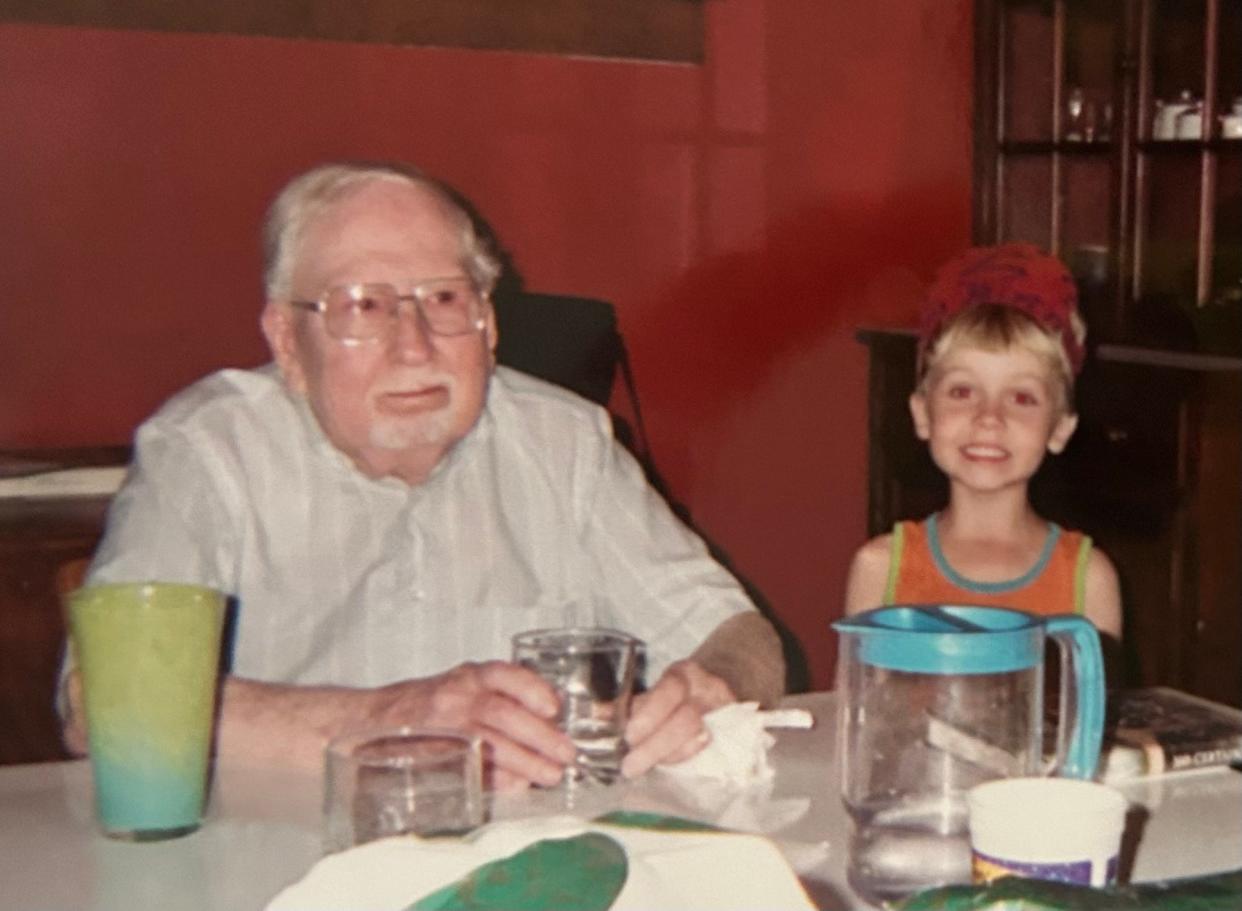Annual return of hollyhocks welcome reminder of old friend | Holly Christensen

Every Mother's Day, my children wash my car and help me plant flowers. Last week, as I prepared the garden beds of my two side-by-side homes, I found one of what I call "Claire's hollyhocks" growing where it didn't belong and relocated it alongside its cohorts.
One morning in the spring of 2005, my next-door neighbor, Claire Cressler, walked over to chat while I gardened. Our century-old homes have a feature that zoning ordinances long ago disallowed: a shared driveway. Twenty years ago, our yards were populated with oak trees (two dramatically fell over, roots and all, in the years since), leaving scarcely a sunny spot for flowers to grow. The best place was in the narrow strip of earth between the side of my home and our shared driveway.
When he joined the Army in World War II, Claire was 5-foot-7, but after 95 years of gravity tugging on his frame, he was a good bit shorter than me. He drove to the barber’s every four weeks to trim his impressively thick, white hair. On either side of a well-groomed goatee, Claire's cheeks were jowly and usually clean-shaven. A retired artist, Claire's clothes were old, but stylish. That day he wore a plaid shirt, Levis and a cowboy belt. As always when we talked, Claire immediately began turning up the volume in his right ear.
“How’s your garden coming? Do you have all your plants in?” he asked.
“I still have a flat of coleus to put in pots on the patio, but I’m done here on the side of the house.”
I was happy to see Claire outside. He'd had shingles earlier that spring and I was concerned by how long it took him to recover. In previous springs, he'd do a little yard work every day, neatly bundling yard waste with twine. That year, his yard was littered with the debris continuously dropped by mature oaks: catkins, acorns, leaves, twigs and the occasional branch. Dead hydrangea flowers and iris leaves from the previous summer hadn’t been cut back. Geraniums he had wintered in his basement had yet to return to their summer home on his back stoop.
“Say, do you know what flower I liked as a boy?”
“No,” I answered, “What?”
“Hollyhocks.”
"Really?" I asked. A flower of a bygone era, hollyhocks had diminished in popularity long before I was born.
“Yeah, I know many people think they are a crude flower, but I always liked them.” Oddly enough, the day before I had seen packets of heirloom hollyhock seeds at Crown Point Ecology Center. Written on the back of the packets was the flower's history.
“You know, Claire, I read that hollyhocks were a favorite flower to plant around outhouses. Do you suppose that's why they were considered crude?”
“Well, now, that could be,” he said. “I remember when I was a boy, I liked to walk home from school through the alleyways and I would always see hollyhocks growing along the back fences of peoples’ yards.”
“Were there still many outhouses in Decatur when you were a boy?”
“Oh, sure. We called them Chick Sales.”
“Chicksalls?” I asked.
“No, Chick Sales,” he responded, adding emphasis to the separation of the two words. “Chick Sales was a comedian of sorts who told jokes about outhouses, so people started calling the outhouses Chick Sales after him and they called him The Specialist because he, well, specialized in outhouses.”
“Wait, was this before radio?”
“Oh, sure,” he again answered.
“So was Chick Sales a vaudevillian?” I asked, curious how a man’s name became to outhouses what Kleenex is to tissue.
“No,” answered Claire, “I don’t recall that he did vaudeville, he might’ve, I suppose. His jokes were in books that adults would talk about but wouldn’t let us kids read.”
“Can you tell me any?” I asked.
"It's been so long, I can't remember exactly. I recall he talked about outhouses with grand descriptions of their architecture and the crescent moon on the doors. He also had jokes about the trains going through Arkansas."
"Arkansas?" I asked.
“Yes. You see in those days, they had boys that went up and down the train cars selling nuts and crackers and that sort of thing. Well, on a train through Arkansas, Chick Sales sees an old man selling this stuff and he asks him, ‘Aren’t you supposed to be a boy?’ and the old man replies, ‘Well, I was when we started out.’" I chuckled.
“It was a slow train, you see,” Claire explained in case I didn’t get it. “But you know, I really did think those hollyhocks were special when I’d see them, they just made me smile.”
Sometimes I'm a bit slow on the draw. It suddenly occurred to me why Claire had come out to discuss hollyhocks while I was gardening.
“Claire, would you like me to plant some hollyhocks along the driveway?
“Well, that’d be all right, I suppose.” A few days later I told him I had planted his seeds.
“Oh, show me where you put them, so as I know where to look.”
“I put most of them under my kitchen window where you can see them when you are at your kitchen sink.”
“Well, that’ll be just fine.”
Hollyhocks reseed themselves, returning each year. They start out as bushy mounds of broad leaves, not unlike rhubarb. By June, the center stalks will have shot up 6-to-8 feet. Throughout the summer, the stalks will be covered in large, multi-colored blossoms. Today, I live in Claire's house and from what is now my kitchen window, I enjoy seeing the descendants of that first packet of hollyhock seeds. Claire's hollyhocks.
Contact Holly Christensen at whoopsiepiggle@gmail.com.
This article originally appeared on Akron Beacon Journal: Annual return of hollyhocks reminder of old friend | Holly Christensen
